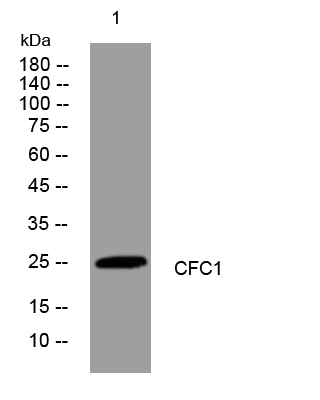- Home
- About
- Promotions
-
Products
-
Elisa Kits
- |
-
Primary antibodies
- |
-
Secondary antibodies
- |
-
Proteins
- |
-
IHC reagents
- |
-
WB reagents
- PonceauS Staining Solution
- PBST Washing Buffer, 10X
- 1.5M Tris-HCl Buffer, pH8.8
- 1M Tris-HCl Buffer, pH6.8
- 10% SDS Solution
- Prestained Protein Marker
- TBST Washing Buffer, 10X
- SDS PAGE Loading Buffer, 5X
- Stripping Buffered Solution
- Tris Buffer, pH7.4, 10X
- Total Protein Extraction Kit
- Running Buffer, 10X
- Transfer Buffer, 10X
- 30% Acr-Bis(29:1) Solution
- Tris电泳液速溶颗粒
- PBS(1X, premixed powder)
- TBS(1X, premixed powder)
- 快速封闭液
- 转膜液速溶颗粒
- Chemical reagents
- News
- Distributor
- Resources
- Contact
- Home
- >
- Info
- >
- CFC1 rabbit pAb
- >
- Go Back
CFC1 rabbit pAb
- Catalog No.:YT7309
- Applications:WB
- Reactivity:Human;Mouse
- Immunogen:
- Synthesized peptide derived from human CFC1 AA range: 129-179
- Specificity:
- This antibody detects endogenous levels of CFC1 at Human/Mouse
- Formulation:
- Liquid in PBS containing 50% glycerol, 0.5% BSA and 0.02% sodium azide.
- Source:
- Polyclonal, Rabbit,IgG
- Purification:
- The antibody was affinity-purified from rabbit antiserum by affinity-chromatography using epitope-specific immunogen.
- Storage Stability:
- -15°C to -25°C/1 year(Do not lower than -25°C)
- Molecular Weight(Da):
- 25kD
- Background:
- This gene encodes a member of the epidermal growth factor (EGF)- Cripto, Frl-1, and Cryptic (CFC) family, which are involved in signalling during embryonic development. Proteins in this family share a variant EGF-like motif, a conserved cysteine-rich domain, and a C-terminal hydrophobic region. The protein encoded by this gene is necessary for patterning the left-right embryonic axis. Mutations in this gene are associated with defects in organ development, including autosomal visceral heterotaxy and congenital heart disease. Alternatively spliced transcript variants encoding multiple isoforms have been observed for this gene. [provided by RefSeq, Jul 2012],
- Function:
- disease:Defects in CFC1 are a cause of conotruncal heart malformations (CTHM) [MIM:217095]. CTHM consist of cardiac outflow tract defects, such as tetralogy of Fallot, pulmonary atresia, double-outlet right ventricle, truncus arteriosus communis, and aortic arch anomalies.,disease:Defects in CFC1 are a cause of transposition of the great arteries, dextro-looped (DTGA) [MIM:608808]. The more common form of DTGA, consists of complete inversion of the great vessels, so that the aorta incorrectly arises from the right ventricle and the pulmonary artery incorrectly arises from the left ventricle. This creates completely separate pulmonary and systemic circulatory systems, an arrangement that is incompatible with life. Patients often have atrial and/or ventricular septal defects or other types of shunting that allow some mixing between the circulations in order to support life minimally, but s
- Subcellular Location:
- Cell membrane ; Lipid-anchor, GPI-anchor . Secreted . Does not exhibit a typical GPI-signal sequence. The C-ter hydrophilic extension of the GPI-signal sequence reduces the efficiency of processing and could lead to the production of an secreted unprocessed form. This extension is found only in primates.

- Western blot analysis of lysates from HpeG2 cells, primary antibody was diluted at 1:1000, 4°over night




